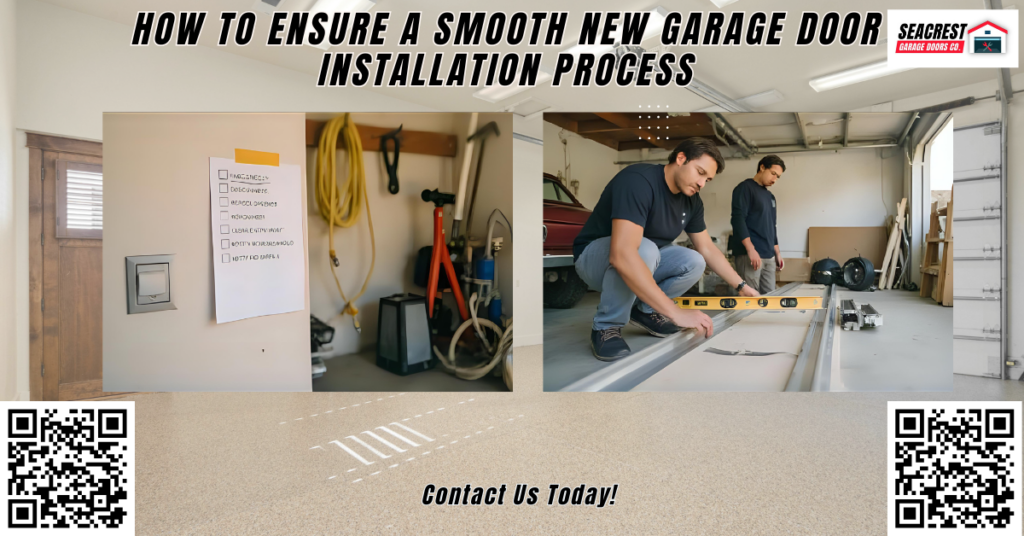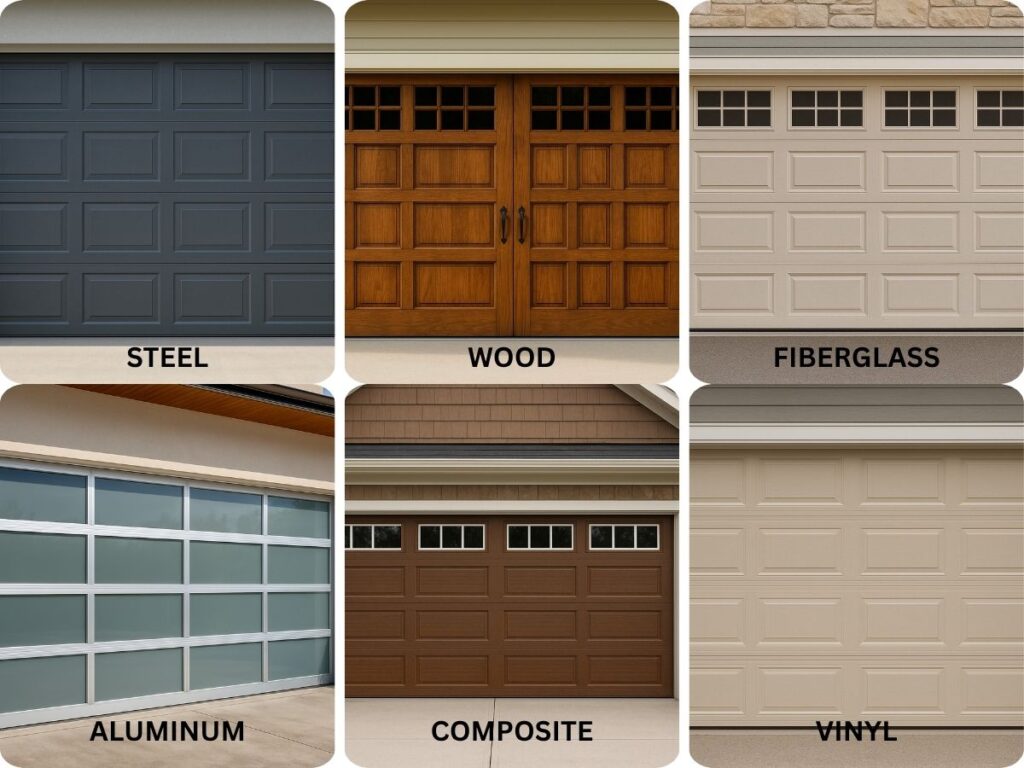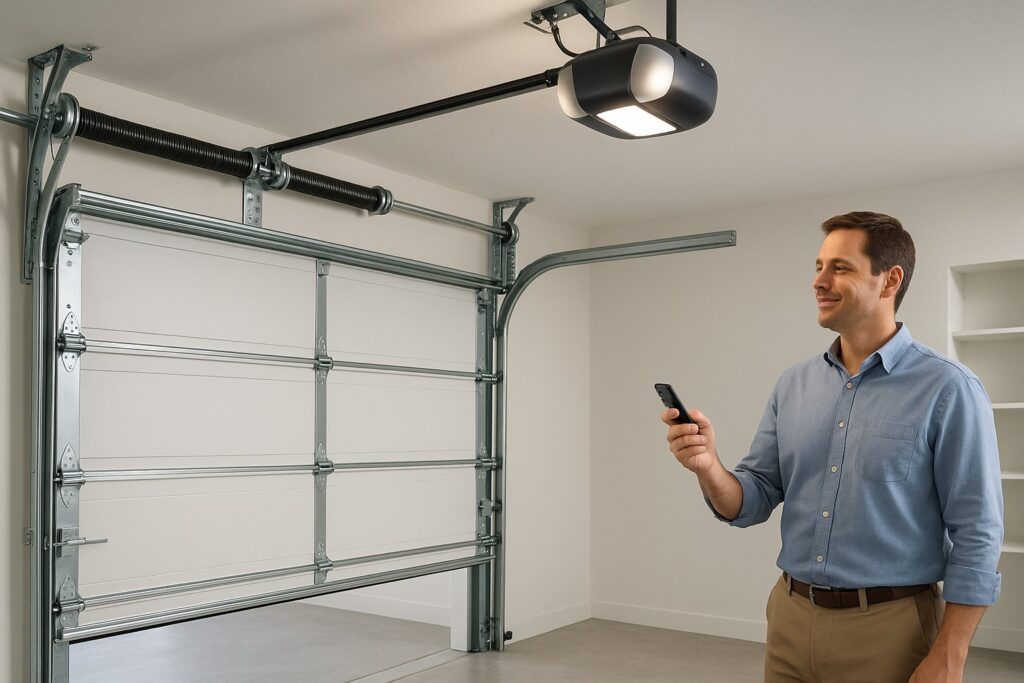How to Ensure a Smooth New Garage Door Installation Process

A few months ago, David O’Mara, a Lincoln homeowner, called us at Seacrest Garage Doors Co. during a brutal Nebraska winter. His garage door had frozen shut, and the old opener stopped working after years of wear and tear. He couldn’t access his car, and cold air was leaking into his home. We quickly installed a new insulated steel door with a smart garage door opener, transforming his garage into a secure, energy-efficient space. Stories like David’s are why we’re passionate about making sure every garage door installation goes smoothly.
According to Remodeling Magazine’s 2024 “Cost vs. Value” report, garage door replacement ranks as one of the top 5 home improvements for return on investment (ROI), often recouping over 90% of the cost in resale value. But a new garage door does more than improve curb appeal. It boosts your home’s security, energy efficiency, and daily convenience, especially when properly installed with modern features like smart technology and advanced safety features.
At Seacrest Garage Doors Co., we specialize in both residential and commercial garage door services across Lincoln, NE, offering repairs, replacements, and custom installations. This comprehensive guide will walk you through every step of the process, from selecting the right garage door style and material to preparing for installation day so you can enjoy a hassle-free experience.
Why a New Garage Door Matters
Installing a new garage door is more than a cosmetic decision; it’s a key upgrade that directly affects your home’s functionality, value, and safety. The right garage door can improve your home’s energy efficiency by sealing out hot or cold air, which helps reduce utility bills. For homes in colder regions like Lincoln, insulated doors with a high R-value are especially important to maintain indoor comfort during the winter.
Security is another major reason to upgrade. Older garage doors often lack modern safety features such as automatic reversal systems, rolling code technology, and reinforced locks. Newer garage door openers can even sync with security cameras and smart home systems, letting you monitor and operate your garage remotely.
The design of your garage door also plays a major role in your home’s curb appeal. Whether you choose wood, steel, vinyl, or fiberglass, an updated garage door style like carriage house, sectional, or contemporary flush-panel can add elegance and character to your property. With a variety of colors, finishes, window inserts, and panel designs, your new garage door can become a centerpiece of your home’s exterior.
Step 1: Know When It’s Time for a New Garage Door
Several factors signal it’s time for a garage door replacement. Age is often the most obvious most garage doors last around 15 to 30 years, depending on the material, usage, and exposure to elements. If your door shows visible signs of rust, delamination, sagging, or warping, especially with wooden garage doors, it may be time for a new one.
Operational problems can also point to the need for a replacement. If your door makes excessive noise, operates unevenly, or fails to respond to remote commands, the issue could go beyond basic garage door repairs and require a full replacement. Broken springs, misaligned tracks, and malfunctioning openers can affect performance and safety.
Additionally, homeowners looking to sell may want to consider replacing outdated garage doors to increase property value and improve first impressions. Even if the door still works, updating to a modern design with smart features can significantly boost buyer interest.
Step 2: Decide What Type of Garage Door You Need
Choosing the right garage door is critical to matching your home’s style, meeting your functional needs, and staying within your budget. Today’s garage doors come in a wide range of styles, materials, and price points. Understanding your options will help you make an informed decision.
Material Options
- Steel Doors: The most popular choice due to their durability and low maintenance. Available in various finishes and can include polyurethane insulation for better energy efficiency.
- Wood Garage Doors: Classic and elegant, but more expensive and high-maintenance. Best for custom or historic homes seeking a traditional look.
- Aluminum: Lightweight and rust-resistant, making it ideal for modern garage designs. However, they can dent easily.
- Vinyl: Durable and resistant to denting and cracking. A great option for families with kids and pets.
Fiberglass and Composite: Mimic the look of wood without the upkeep. Good resistance to salt air and moisture, perfect for humid environments.

Style Options
- Sectional Garage Doors: Made of horizontal panels that open vertically and lie flat against the ceiling—great for saving space.
Carriage House: Decorative and timeless, these mimic old-fashioned barn doors and often include elegant handles and hinges. - Contemporary/Flush Panel: Sleek and minimal for modern homes.
- French Doors: Though rare in garages, they’re a luxurious custom option for multi-use garages or studios.
Consider adding windows, decorative hardware, or insulation depending on your climate, style preference, and usage.
Step 3: Measure Before You Order
Proper sizing is one of the most important steps in the installation process. Inaccurate measurements can lead to order delays, added costs, and doors that simply won’t fit. Use this garage door guide to collect the right dimensions:
- Opening Width & Height: Measure the width and height of the finished opening. This determines the door size.
- Headroom: Measure the distance between the top of the opening and the ceiling. You’ll need enough room for tracks, springs, and openers.
- Backroom: The space behind the garage must accommodate the length of the door as it opens.
- Side Room: Measure the space on both sides of the opening for tracks and brackets.
Professional installers like Seacrest Garage Doors Co. always verify measurements during the initial site visit. Still, having a basic idea in advance helps you explore realistic options.
Step 4: Choose a Reputable Garage Door Installer
Even the best garage doors won’t perform well if installed incorrectly. A professional installation ensures that your new system is safe, balanced, and reliable. Our team at Seacrest Garage Doors Co. includes certified technicians who are trained in the latest products and installation methods.
Avoid hiring a handyman who lacks specific experience with garage door systems. Improper tensioning of garage door springs or misalignment of tracks can lead to serious injury or system failure. Instead, look for companies that:
- Are licensed, bonded, and insured
- Have positive online reviews
- Provide detailed estimates and timelines
- Offer warranties on labor and materials
- Work with major brands like Wayne Dalton, Overhead Door, and Craftsman
A quality installation company will also advise you on local building codes, safety regulations, and climate considerations, such as doors with high wind resistance ratings or extra insulation for cold-weather performance.
Step 5: Prepare Your Garage for Installation Day
To keep the installation process smooth and efficient, it’s helpful to prepare the space in advance. Installers need a clean, open area to work safely and quickly.
Here’s how to get ready:
- Clear the Garage: Move vehicles, bikes, and any bulky items out of the way.
- Remove Wall Obstructions: Take down hanging tools or shelves near the installation area.
- Cover Stored Items: Dust and debris can fall during the process, so cover anything you want to protect.
- Inform Household Members: Keep kids and pets away from the work zone for safety.
- Check Lighting and Power Access: Ensure the garage has working lights and outlets for tool use.
These small actions save time and prevent unnecessary delays on installation day.
Step 6: What Happens During Installation
Professional garage door installation usually takes between 3 to 6 hours, depending on installation complexity and additional features like smart openers, security systems, or custom garage doors.
The process typically includes:
- Old Door Removal: The crew safely dismantles the existing door, tracks, and hardware. This step includes the safe removal of high-tension springs.
- Track and Frame Setup: New vertical and horizontal tracks are mounted and secured to the garage structure.
- Spring Installation: Depending on the door type, either torsion or extension springs are installed. These components balance the door’s weight.
- Panel Assembly: For sectional doors, each panel is placed and attached sequentially.
- Opener Setup: The garage door opener is mounted, wired, and synced with remotes or smartphone apps.
- Testing and Adjustment: Safety features, auto-reverse functions, and door balance are thoroughly tested.
- Cleanup and Orientation: Installers clean the area and guide the homeowner through operation and maintenance tips.
By working with seasoned technicians, you ensure every part—from batteries to belt drives—is professionally installed and functioning properly.
Step 7: Inspect the Finished Product
After installation, it’s important to inspect your new garage door to confirm everything is working correctly.
Use this checklist:
- Smooth Operation: The door should open and close without jerking, squeaking, or sticking.
- Sealing: Look for tight seals along the edges to block drafts, pests, and moisture.
- Remote Access: Ensure all remotes, keypads, or smart controls are responsive.
- Safety Features: Test the auto-reverse by placing a small object under the door. It should stop and reverse on contact.
- Security: Check if the lock works properly and ask how to reset rolling codes if applicable.

If you notice any issues, contact your installer right away for adjustments or garage door service.
Step 8: Understand Maintenance and Warranties
Garage doors require routine maintenance to stay safe and last for years. A well-maintained door can last 20–30 years or more. Without it, components like springs, cables, or rollers can wear out early and lead to costly repairs.
Tips for ongoing care:
- Lubricate moving parts every 3–6 months
- Inspect cables and tracks for wear or rust
- Tighten bolts and brackets annually
- Replace remote batteries as needed
- Clean door panels to prevent buildup and delamination
Additionally, review your warranty coverage. Most manufacturers offer:
- 10–15 years on the door material and finish
- 3–5 years on hardware
- 1 year or more on labor
Save your receipts and warranty documents in case you need repairs or replacement parts down the line.
Step 9: Know When to Call for Help
Even with regular maintenance, things can go wrong, especially in cold climates or high-usage homes. Call a professional if you notice:
- A loud grinding noise or slow movement
- A door that won’t close fully
- A remote or keypad that stops working
- A door that’s unbalanced or crooked
Trying to fix a garage door spring or opener yourself can be dangerous. Leave repairs to trained professionals like those at Seacrest Garage Doors Co., who can safely inspect and restore functionality.
Why Hiring a Local Company Makes a Difference
Working with a local, reputable company like Seacrest Garage Doors Co. means faster response times, personal customer care, and better knowledge of Lincoln’s unique climate challenges. We’re familiar with the materials that perform best in our cold winters and humid summers.
We also stay current with local codes and building regulations, which helps ensure your installation passes inspection. Plus, we’re always nearby if you need future garage door services, including repairs, opener upgrades, or door replacement.
Common Mistakes to Avoid
Avoiding these common errors can save you time and money:
- Ordering the wrong size or type of door
- Skipping insulation in climates like Nebraska
- Choosing style over function (e.g., wood without understanding upkeep)
- Neglecting safety features like auto-reverse and motion sensors
- Trying a DIY installation without proper training or tools
Your best bet is to follow a comprehensive garage door guide like this one and work with trusted professionals from the start.
Final Thoughts
A new garage door is a smart investment that enhances your home’s style, energy savings, and security. But achieving a smooth and stress-free garage door installation takes preparation, smart decision-making, and expert help. From selecting the best garage door materials to ensuring safe installation and long-term care, this guide gives you the tools to make the process successful.
At Seacrest Garage Doors Co., we’re proud to be Lincoln’s trusted partner in everything from garage door repairs to custom installations. Let’s work together to transform your home with a beautiful, efficient, and reliable garage door.
How Can Seacrest Garage Doors Co. Help You?
Looking for a hassle-free garage door replacement or a new garage door opener? Trust the experienced team at Seacrest Garage Doors Co. for top-notch service in Lincoln, NE, and surrounding areas.
We offer:
- Free in-home estimates and door design consultations
- Wide selection of garage door styles, colors, and materials
- Expert garage door installation by licensed technicians
- Smart garage door openers with modern safety features
- Affordable repair and maintenance services
📍 Visit Us:
6891 A St #104, Lincoln, NE 68510, United States
📞 Call Today: (402) 374-9880
Let’s get started on your new garage door—contact Seacrest Garage Doors Co. now to schedule your free consultation!
Frequently Asked Questions (FAQs)
1. How long does a garage door installation typically take?
A standard residential garage door installation usually takes 3 to 6 hours, depending on the complexity and whether a new opener is being installed. Custom or oversized doors may take longer. The installer will also perform safety checks and a full system test after installation.
2. What is the best garage door material for cold climates like Nebraska?
Insulated steel or composite garage doors are best for cold-weather climates. These materials have high R-values to retain heat and resist moisture. Avoid wood if you’re concerned about warping or cracking from temperature swings.
3. Can I reuse my old garage door opener with a new door?
In some cases, yes—if the opener is compatible with your new door’s weight and type. However, older openers may lack modern safety features and smart technology. It’s often more cost-effective to upgrade during replacement.
4. What is the average cost of a new garage door, including installation?
On average, a new garage door with installation costs range from $1,000 to $3,500, depending on the size, materials, insulation, and added features. Custom designs or smart openers may increase the price. Always request a written estimate before starting work.
